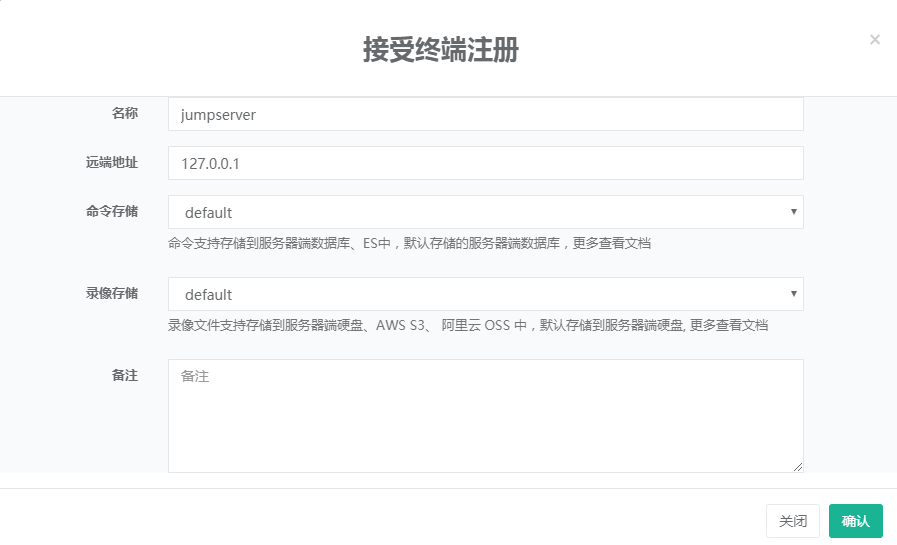关闭防火墙和selinux
IP:192.168.199.115
一. 准备 Python3 和 Python 虚拟环境
yum -y install wget sqlite-devel xz gcc automake zlib-devel openssl-devel epel-release git
wget https://www.python.org/ftp/python/3.6.1/Python-3.6.1.tar.xz
tar xvf Python-3.6.1.tar.xz && cd Python-3.6.1
./configure && make && make install
cd /opt python3 -m venv py3 source /opt/py3/bin/activate # 看到下面的提示符代表成功,以后运行 Jumpserver 都要先运行以上 source 命令,以下所有命令均在该虚拟环境中运行 (py3) [root@localhost py3]
二. 安装 Jumpserver 1.0.0
2.1 下载或 Clone 项目
项目提交较多 git clone 时较大,你可以选择去 Github 项目页面直接下载zip包,我是下载安装包之后安装
cd /opt/ #git clone --depth=1 https://github.com/jumpserver/jumpserver.git && cd jumpserver && git checkout master (从官网下载直接安装)
下载安装包之后把下载的jumpserver-master.zip上传到 /opt目录
unzip jumpserver-master.zip
mv jumpserver-master jumpserver
2.2 安装依赖 RPM 包
cd /opt/jumpserver/requirements yum -y install $(cat rpm_requirements.txt) # 如果没有任何报错请继续
2.3 安装 Python 库依赖
pip install -r requirements.txt # 不要指定-i参数,因为镜像上可能没有最新的包,如果没有任何报错请继续
2.4 安装 Redis, Jumpserver 使用 Redis 做 cache 和 celery broke
yum -y install redis systemctl start redis
systemctl enable redis
2.5 安装 MySQL
yum -y install mariadb mariadb-devel mariadb-server # centos7下安装的是mariadb systemctl start mariadb systemctl enable mariadb
2.6 创建数据库 Jumpserver 并授权
$ mysql > create database jumpserver default charset 'utf8'; > grant all on jumpserver.* to 'jumpserver'@'127.0.0.1' identified by 'jason_zhang';
2.7 修改 Jumpserver 配置文件
$ cd /opt/jumpserver $ cp config_example.py config.py $ vi config.py # 修改其中 DevelopmentConfig的配置,因为默认jumpserver是使用该配置,它继承自Config
(py3) [root@jason jumpserver]# cat config.py |grep -Ev '^$|^#' """ jumpserver.config ~~~~~~~~~~~~~~~~~ Jumpserver project setting file :copyright: (c) 2014-2017 by Jumpserver Team :license: GPL v2, see LICENSE for more details. """ import os BASE_DIR = os.path.dirname(os.path.abspath(__file__)) class Config: # Use it to encrypt or decrypt data # SECURITY WARNING: keep the secret key used in production secret! SECRET_KEY = os.environ.get('SECRET_KEY') or '2vym+ky!997d5kkcc64mnz06y1mmui3lut#(^wd=%s_qj$1%x' # Django security setting, if your disable debug model, you should setting that ALLOWED_HOSTS = ['*'] # Development env open this, when error occur display the full process track, Production disable it DEBUG = os.environ.get("DEBUG") or True # DEBUG, INFO, WARNING, ERROR, CRITICAL can set. See https://docs.djangoproject.com/en/1.10/topics/logging/ LOG_LEVEL = os.environ.get("LOG_LEVEL") or 'DEBUG' LOG_DIR = os.path.join(BASE_DIR, 'logs') # Database setting, Support sqlite3, mysql, postgres .... # See https://docs.djangoproject.com/en/1.10/ref/settings/#databases # SQLite setting: DB_ENGINE = 'sqlite3' DB_NAME = os.path.join(BASE_DIR, 'data', 'db.sqlite3') # MySQL or postgres setting like: # DB_ENGINE = os.environ.get("DB_ENGINE") or 'mysql' # DB_HOST = os.environ.get("DB_HOST") or '127.0.0.1' # DB_PORT = os.environ.get("DB_PORT") or 3306 # DB_USER = os.environ.get("DB_USER") or 'jumpserver' # DB_PASSWORD = os.environ.get("DB_PASSWORD") or 'weakPassword' # DB_NAME = os.environ.get("DB_NAME") or 'jumpserver' # When Django start it will bind this host and port # ./manage.py runserver 127.0.0.1:8080 HTTP_BIND_HOST = '0.0.0.0' HTTP_LISTEN_PORT = 8080 # Use Redis as broker for celery and web socket REDIS_HOST = os.environ.get("REDIS_HOST") or '127.0.0.1' REDIS_PORT = os.environ.get("REDIS_PORT") or 6379 REDIS_PASSWORD = os.environ.get("REDIS_PASSWORD") or '' REDIS_DB_CELERY = os.environ.get('REDIS_DB') or 3 REDIS_DB_CACHE = os.environ.get('REDIS_DB') or 4 def __init__(self): pass def __getattr__(self, item): return None class DevelopmentConfig(Config): DEBUG = True DB_ENGINE = 'mysql' DB_HOST = '127.0.0.1' DB_PORT = 3306 DB_USER = 'jumpserver' DB_PASSWORD = 'jason_zhang' DB_NAME = 'jumpserver' class TestConfig(Config): pass class ProductionConfig(Config): pass config = DevelopmentConfig()
2.8 生成数据库表结构和初始化数据
cd /opt/jumpserver/utils bash make_migrations.sh
2.9 运行 Jumpserver
cd /opt/jumpserver
python run_server.py all (这个xshell界面不能停止运行,另打开一个进行接下来的操作)
运行不报错,请浏览器访问 http://192.168.199.115:8080/
账号: admin 密码: admin
三. 安装 SSH Server 和 WebSocket Server: Coco
新开一个终端,运行Python3虚拟环境
source /opt/py3/bin/activate
3.1 下载或 Clone 项目
cd /opt git clone https://github.com/jumpserver/coco.git && cd coco && git checkout master
3.2 安装依赖
cd /opt/coco/requirements yum -y install $(cat rpm_requirements.txt) pip install -r requirements.txt
3.3 查看配置文件并运行
cd /opt/coco cp conf_example.py conf.py python run_server.py
这时需要去 Jumpserver 管理后台-会话管理-终端管理,(http://192.168.199.115:8080/terminal/terminal/)接受 Coco 的注册


四. 安装 Web Terminal 前端: Luna
另开一个终端,运行Python3虚拟环境
Luna 已改为纯前端,需要 Nginx 来运行访问
访问(https://github.com/jumpserver/luna/releases)下载对应版本的 release 包,放在/opt目录下,直接解压,不需要编译
4.1 解压 Luna
tar xvf luna.tar.gz